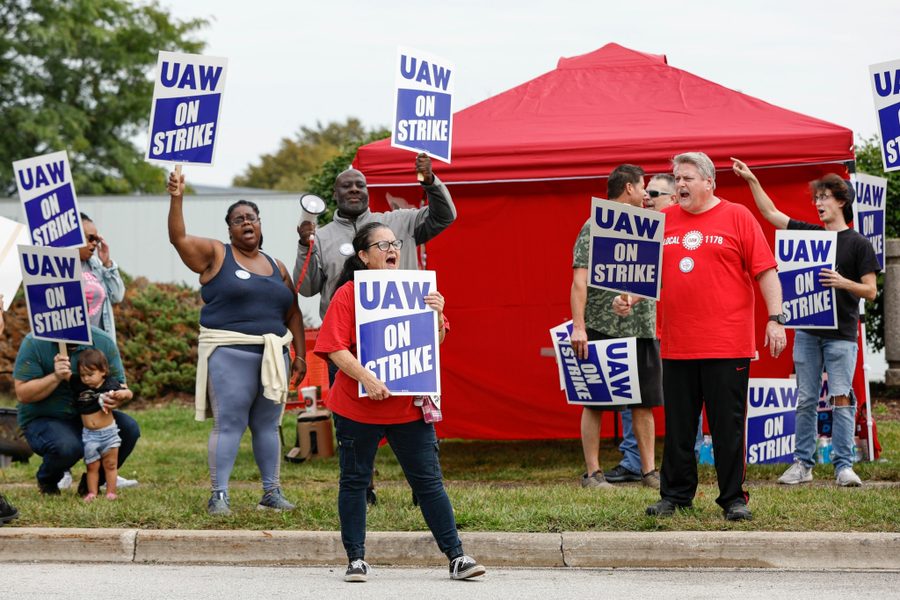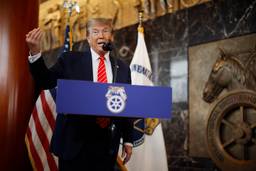Here’s What UAW Workers Won in a “Historic” TA After Striking at Ford
After more than a month on the picket line, autoworkers have reached a tentative agreement with Ford including massive wage increases, cost of living adjustments and the right to strike over plant closures. Now the deal goes to the membership, while strikes continue at GM and Stellantis.
Jeff Schuhrke

Forty days into their nationwide Stand-Up Strike, the United Auto Workers (UAW) yesterday reached a tentative agreement with the first of the Big Three automakers. On Wednesday night, UAW President Shawn Fain and Vice President Chuck Browning announced that a deal had been reached with Ford — with Browning calling it “the most lucrative agreement per member” in several decades and Fain hailing it as “a historic agreement.”
“We won things nobody thought possible,” Fain said in a video message. “Since the strike began, Ford put 50% more on the table than when we walked out. This agreement sets us on a new path to make things right at Ford, at the Big Three and across the auto industry. Together, we are turning the tide for the working class in this country.”
The tentative agreement comes after the Stand-Up Strike expanded to include 6,800 workers at Stellantis’ Sterling Heights Assembly Plant in Michigan on Monday and then 5,000 workers at General Motors’ Arlington Assembly Plant in Texas on Tuesday.
“Ford knew what was coming for them on Wednesday if we didn’t get a deal. That was checkmate,” Fain said.
Illustrating how the innovative tactic of simultaneously striking at all three automakers pits the companies against each other, the pressure is now on GM and Stellantis to also reach a deal as Ford strikers will return to work.
As Browning explained, “The last thing [GM and Stellantis] want is for Ford to get back to full capacity while they mess around and lag behind.”
Last month, Ford also was the first of the Big Three to settle with Unifor, the Canadian autoworkers’ union.
Full details of the UAW’s tentative agreement will not be made public until Sunday evening at the earliest, assuming the union’s National Ford Council — which will meet that day in Detroit — votes to send the deal to the membership for approval.
In the meantime, Fain and Browning provided some highlights of what was won in the agreement, which could serve as a model for deals at the other two automakers:
A 25% general wage increase over the 4.5-year life of the contract. In comparison, the union secured 23% in total wage increases in the 21 years from 2001 to 2022, according to a UAW infographic.
Restoration of the cost-of-living adjustment (COLA), which ties wage increases to inflation, after it was suspended in 2009 amid bankruptcies at GM and Chrysler (now Stellantis).
Elimination of wage tiers at Ford’s Sterling Axle and Rawsonville plants in Michigan, with lower-tier workers at these facilities seeing an immediate 85% raise upon the contract’s ratification.
Reduction of the amount of time new hires must wait to reach maximum wage levels from eight years to three years, as it had been before a major union concession in 2007.
A 150% wage increase for temp workers over the life of the contract.
An approximately 68% increase to the starting wage and a roughly 33% increase to the top wage. All Ford workers will see an immediate 11% increase on ratification, which Browning said was “almost equal to all of the wage increases since 2007 combined.”
Increased retirement benefits to workers with pensions and to workers with 401(k)s (Fain and Browning did not provide further details).
For the first time, the right to strike over plant closures — a key UAW demand to help protect autoworkers’ jobs.
The highlights provided by Fain and Browning did not mention whether the contract would be extended to Ford’s joint venture electric vehicle (EV) battery plants, which has also been an important UAW goal during the strike.
“I haven’t seen the entire agreement yet to know what type of language they might be changing, but looking at the highlights, there’s definitely things there that I didn’t have when I started at Ford,” says Robert Kacher, a UAW Local 551 member who has worked at the company’s Chicago Assembly Plant since 2012.
Kacher, who has been on strike since September 29, tells In These Times he is waiting for more instructions from union leadership on returning to work at the plant, but noted that it will take a few days before production is back up to full capacity.
He says he is eager to see whether the contract addresses threats to job security from new technology and automation, and adds that he had hoped the union would win pensions for workers like him hired after 2007, who all receive 401(k)s instead.
“They did say they were going to increase contributions to the 401(k), so I can’t complain, it’s going to help. But I think a pension is definitely going to be something I’ll be fighting for in the future,” Kacher says.
“I know we can’t get everything out of this,” he continues. “We’ll see what the membership says. Some of the people I talked to don’t think it’s good enough. But a 25% raise over the lifetime — I’ve never had that. I’ve never had COLA.”
Addressing the UAW rank and file, Fain said Thursday night, “Everything we did at the bargaining table, every extra hundred million we got the company to give up, was because of you, the members.”
As with the recently concluded Writers Guild of America strike, as well as the credible strike threat the Teamsters posed to UPS this summer, the gains achieved in the UAW’s tentative agreement again show that when unions take an aggressive stance and workers withhold their labor (or even threaten to do so), employers are forced to make concessions previously said to be “impossible.”
If the UAW National Ford Council votes on Sunday to send the tentative agreement to the membership, the union will send more details to the rank and file that evening and will hold a Facebook Live stream to review the agreement publicly. Afterward, members at Ford will have an opportunity to discuss the proposed contract in-depth at regional and local union meetings before voting on whether to ratify it.
“The ultimate authority in our union is the membership,” said Fain. “We decide together whether we’ve won enough or whether we need to keep fighting for more. The membership decides. We collectively decide just like we collectively bargain.”
Compared to previous contract negotiations since he has been a UAW member, Kacher says Fain has “gone to the limit” and “pulled some good stuff off.”
“He’s leaving it to the membership, so if we vote no, he’s got to fight harder for us,” Kacher explains. “If we had fought harder in the past, we wouldn’t be pulling teeth today.”
Jeff Schuhrke is a labor historian and assistant professor at the Harry Van Arsdale Jr. School of Labor Studies, SUNY Empire State University. He is the author of Blue-Collar Empire: The Untold Story of US Labor’s Global Anticommunist Crusade.







